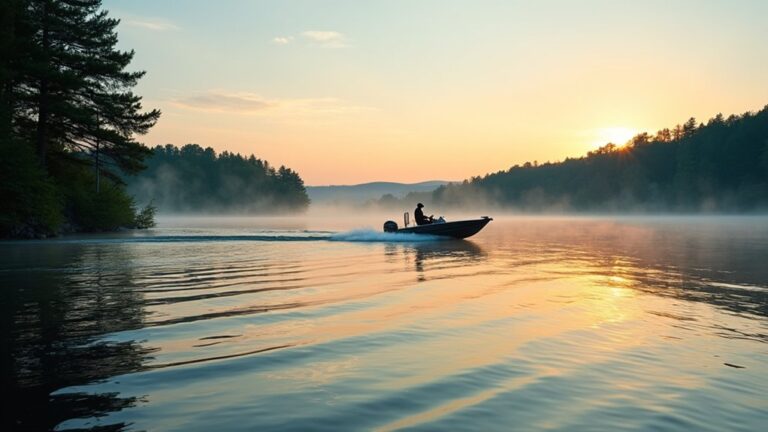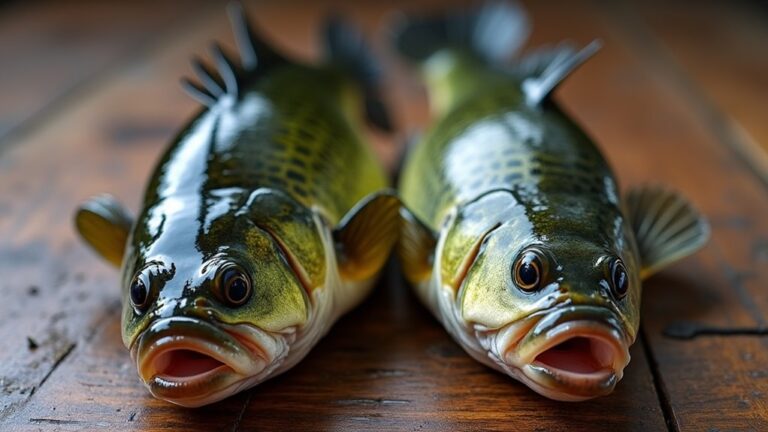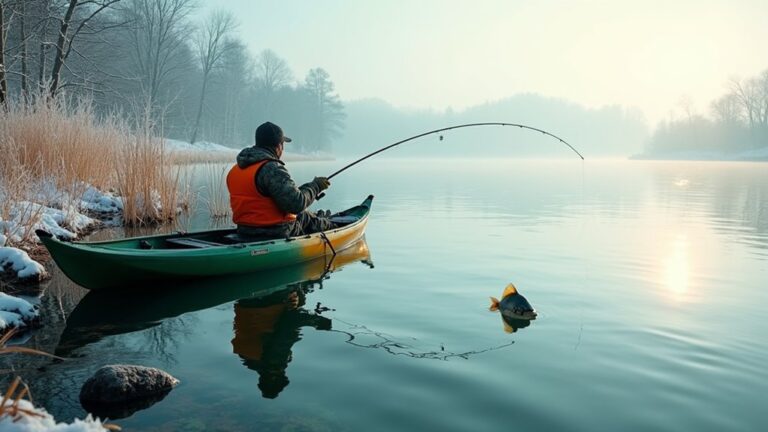You'll find shoal bass in Georgia's swift, rocky rivers, particularly the Flint River, where these aggressive fighters strike hard and fast. Equip yourself with a 6/7 weight fly rod, floating line, and a sturdy leader that tapers to 12-pound tippet. Target rocky areas, shoals, and riffles during dawn and dusk for best results. Use streamers and poppers in natural colors, and practice catch-and-release to protect these special fish. The secrets to landing trophy shoal bass await below.
The Allure of Georgia's Shoal Bass
Adventure seekers in the Southeast have discovered a hidden gem in Georgia's rivers – the shoal bass. When you're fishing for shoal bass in swift, rocky waters, you'll encounter a unique species of black bass that's as challenging as it's beautiful.
These fighters, distinguished by their three black stripes, will test your fly rod skills as they aggressively strike both surface and subsurface presentations.
You'll find some of the best action in the Flint River, where free-flowing waters create perfect shoal bass habitat. While most catches weigh around a pound, don't be surprised if you hook into an eight-pounder. Optimal fishing occurs during low light conditions, making dawn and dusk ideal times to target these elusive fish.
These special fish need your help, though. Their limited range and specific habitat requirements make them a species of conservation concern, so practice catch-and-release to preserve this exciting fishery.
Essential Gear and Tackle Setup
Three key components form the foundation of an effective shoal bass setup: a 6/7 weight fly rod, floating line, and sturdy leader.
You'll want to pair your weight rod with either floating or intermediate fly line to tackle the fast currents this species of fish calls home. Match this with a 5-foot leader that tapers down to a 12-pound tippet, giving you the perfect balance of strength and casting ability.
When selecting flies for your section of river, focus on streamers and poppers in natural and olive colors. Patterns like Sculperinos and Rabbits Foot flies have proven highly effective.
While these bass average around one pound, don't be surprised when you hook into a trophy exceeding 17 inches – that's why proper gear selection is essential for landing these powerful fighters. Understanding the importance of catch-and-release practices can enhance your fishing experience and contribute to conservation efforts.
Prime Locations Along the Flint River

While the Flint River stretches for hundreds of miles through Georgia, the most productive shoal bass fishing lies between Gay and Lake Seminole.
You'll find excellent public access at Sprewell Bluff State Park and Big Lazer Creek Wildlife Management Area, where rocky shoals create perfect habitats for these prized fish.
For a more secluded experience, book a guided trip to 3-Mile Shoals, where wadeable waters offer prime fishing locations away from crowds.
Experience the river's best features at these spots:
- Deep pools adjacent to swift currents where shoal bass ambush their prey
- Natural rock formations creating pocket water perfect for fly presentation
- Quiet backwaters accessible by canoe or kayak, especially productive after spring rains
Visit during spring when conditions are ideal and fish are most active.
Reading Water for Shoal Bass Success
Successfully reading water for shoal bass requires understanding their natural behaviors and preferred habitats.
You'll find these fish gravitating toward rocky areas with swift water flow, particularly in shoals and riffles where they actively feed. Focus your fishing efforts on current seams and deeper water near undercut ledges, as these spots provide both shelter and prime feeding opportunities.
When targeting shoal bass, you'll want to pay close attention to water clarity and current patterns. These fish prefer clean, moving water, so position yourself to cast near natural obstructions where they're likely to ambush prey.
Consider their feeding habits throughout the seasons, especially during early summer when insect activity peaks. Remember to maintain a stealthy approach, particularly in murky conditions where fish are more easily spooked.
Effective Fly Patterns and Presentations

Once you've located prime shoal bass habitat, selecting the right fly patterns and presenting them effectively will maximize your chances of success.
In areas with good populations of these black basses, you'll want to focus on dark olive streamers and topwater patterns. Strip your fly line quickly through the current, especially during afternoon hours when these aggressive predators are most active.
- Dark olive Sculperinos darting through rocky shoals, mimicking natural prey movements
- Large stimulator patterns skating across the surface during peak insect activity
- Bass poppers creating subtle disturbances in calm pockets between swift runs
For the most effective presentations, use a 5-foot leader tapered to 12-pound tippet. This setup provides the perfect balance of stealth and strength when targeting these hard-fighting fish from spring through fall.
Seasonal Strategies and Timing
As spring rains swell river levels in late March, shoal bass become increasingly active and accessible to fly anglers.
You'll find peak fishing opportunities extending from spring through fall, with consistent action even during the hot summer months.
During winter, you'll need to adjust your approach since these fish retreat to deeper waters.
As temperatures rise in the warmer months, target deeper pools and undercut ledges where shoal bass seek refuge.
Your fishing techniques should adapt accordingly – use weighted dropper setups when probing deep spots, and don't hesitate to switch to topwater flies when fish are actively feeding near the surface.
You can maximize your success by dead-drifting through current lanes and exploring various water depths with a combination of weighted streamers and surface patterns.
Conservation and Catch-and-Release Practices

With their limited geographic range and specialized habitat requirements, shoal bass face increasing conservation challenges that demand careful stewardship from anglers.
You'll play an essential role in their preservation by practicing catch-and-release techniques, especially when you land larger specimens that contribute greatly to the gene pool.
The Georgia Bass Slam program offers an excellent opportunity to promote conservation while enjoying the pursuit of these unique gamefish.
- Handle fish with wet hands to protect their protective slime coating
- Keep the fish in the water while removing hooks and taking photos
- Support the fish's belly and release it only when it shows strong signs of recovery
Advanced Casting Techniques for Moving Water
Successfully casting in moving water demands a refined approach that combines precise technique with an understanding of current dynamics.
When targeting shoal bass, you'll need to position your fly upstream of your target, letting the current naturally carry it to the strike zone.
Master the roll cast for confined spaces where rocks limit your backcast, and employ a quick strip as your fly lands to mimic prey movement.
You'll find that adjusting your casting angle is vital – it helps your fly achieve proper depth while maintaining a natural presentation.
When you're faced with strong currents and need extra distance, the double haul technique becomes invaluable.
This advanced method increases your line speed, allowing you to effectively reach those distant shoal bass holding spots despite challenging water conditions.
Understanding Shoal Bass Behavior

Understanding shoal bass behavior begins with recognizing their unique feeding patterns and habitat preferences. As aggressive feeders, you'll find these fish in swift-moving, rocky river environments where they hunt crawfish, damselflies, and smaller fish.
For the fly angler, it's vital to know that shoal bass exhibit trout-like feeding habits, making them particularly responsive to both surface and subsurface presentations.
- Picture them lurking behind rocks in clear, rushing waters, ready to ambush their prey.
- Imagine their distinct three-stripe pattern flashing as they dart through sunlit shoals.
- Visualize their aggressive strikes, especially during post-rain feeding frenzies in spring.
When targeting shoal bass, you'll want to focus on shallow shoals and riffles where they're most active. Their preference for clear water means they rely heavily on sight-feeding, making them excellent targets for well-presented flies.
Common Mistakes to Avoid on the Water
While mastering shoal bass fly fishing requires skill, avoiding common pitfalls can dramatically improve your success rate. Don't rush into turbid waters without a stealthy approach, as these fish are easily spooked. Perfect your casting techniques by targeting seams and letting the current work with your fly. Understanding fish behavior can also help you anticipate their movements and increase your chances of a catch.
| Mistake | Impact | Solution |
|---|---|---|
| Poor Hook-Setting | Missed Strikes | Use Abrupt Strip Set |
| Wrong Gear Choice | Limited Control | Use 6/7 Weight Rod |
| Limited Fly Selection | Reduced Success | Vary Patterns/Colors |
| Aggressive Approach | Spooked Fish | Stay Stealthy |
Your choice of appropriate gear is essential – pair a 6/7 weight rod with floating or intermediate line and a properly tapered leader. Don't limit your fly selection; experiment with various patterns like Sculperinos and Rabbits Foot flies in natural and olive colors for different conditions.
Frequently Asked Questions
What Is the Best Bait for Shoal Bass?
You'll catch shoal bass using streamers, poppers, and nymphs in natural colors. Weighted streamers work best in deep water, while topwater flies excel during warm months. Don't forget crawfish and damselfly imitations.
Are Shoal Bass Rare?
Yes, you'll find that shoal bass are relatively rare since they're only native to specific rivers in Georgia and Florida. Their limited habitat range and specialized needs for rocky, free-flowing waters make them uncommon.
What Kind of Fly Line for Smallmouth Bass?
You'll want to use a floating or intermediate fly line when targeting smallmouth bass. These lines offer great versatility, letting you fish different depths effectively. A 6 or 7 weight line works best.
Where to Catch Shoal Bass on the Chattahoochee?
You'll find shoal bass near Buford Dam and below Morgan Falls Dam, focusing on rocky structures and fast-moving waters. Target areas with natural shoals and rapids where these bass prefer to feed.
Final Thoughts
You've learned the fundamentals of targeting shoal bass with a fly rod – now it's time to hit Georgia's rivers and put these skills to work. Remember to practice conservation, perfect your casting techniques, and stay patient as you explore the Flint's shoal areas. Whether you're a seasoned angler or new to fly fishing, the thrill of catching these hard-fighting river bass will keep you coming back for more.




